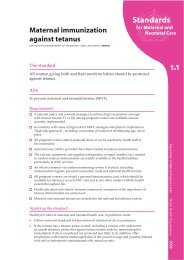1uvZ4zN
1uvZ4zN
1uvZ4zN
Create successful ePaper yourself
Turn your PDF publications into a flip-book with our unique Google optimized e-Paper software.
Volume III<br />
Chapter ONE<br />
Negative perceptions and stereotypes<br />
44. Negative perceptions and stereotypes are a major cause of ethnic tension in the<br />
country. Labels have been put on certain communities, portraying them in broad,<br />
often negative terms that generalise certain traits and apply them to all individuals<br />
belonging to the described community, regardless of how individuals perceive<br />
themselves. For example, the Kikuyu are sometimes described as thieves, the Maasai<br />
as primitive, the Somali as terrorists, etc. The testimony of Commissioner Halakhe<br />
Wago of the National Cohesion and Integration Commission (NCIC) before the<br />
Commission during its thematic hearing on ethnic tension and violence is instructive<br />
in this regard:<br />
There are negative attitudes towards individuals and social groups. For example, for so<br />
long there has been a kind of perception about the pastoralists like the Maasai as always<br />
being primitive. The same pastoralists, courtesy of the Somalis and their likes in the north,<br />
are seen as being warlike. The Kikuyu are thieves because a few people have picked things<br />
here and there or love money because they have been industrious or worked hard. The<br />
Luhya and the Kamba are at times referred to as liars and at times as very loyal. The Luos<br />
think so much about themselves when there is nothing much about them. We hear so<br />
many things about all these communities. The Coastals are deemed lazy people. So,<br />
this has really gone into the minds of many Kenyans to the extent that when they see<br />
me or you, they will definitely know where to place you as long as your name is clearly<br />
understood. 29<br />
45. Wambugu Ngunjiri echoed Halake’s sentiments and further pointed out that<br />
ethnic steretypes have persisted because of the absence of efforts to debunk such<br />
stereotypes:<br />
It is a problem of perceptions, myths and stereotypes about each other. However, nobody<br />
has tried to debunk this and so we have people growing in various communities who have<br />
been told that other communities behave in a certain way without taking time to find<br />
out if it is true. So, we heard conversations that Kikuyus were thieves because a number<br />
of members of government were involved in theft. For example, in Teso, even the small<br />
Kikuyu population is perceived as thieves even though there were no direct incidents of<br />
any of them stealing anything we have reached a point in this country where a lot of our<br />
conversations are not based on facts, but perceptions that have developed over years. 30<br />
46. Most of the negative perceptions and stereotypes that are present today in Kenya<br />
were initially propagated by the colonial government. Besides employing the ‘divide<br />
and rule’ tactic, the colonialist government also perpetuated ethnic stereotyping.<br />
Ethnic stereotyping during the colonial period was a silent culture and is therefore<br />
not well documented. The writings of Kenyans who lived during this period, as well<br />
as the oral testimony of survivors, gave a general sense of the nature and extent of<br />
29. TJRC/Hansard/Thematic Hearing on Ethnic Tension and Violence/2 February 2012/Nairobi/p. 24<br />
30. TJRC/Hansard/Thematic Hearing on Ethnic Tension and Violence/2 February 2012/Nairobi/p. 35<br />
REPORT OF THE TRUTH, JUSTICE AND RECONCILIATION COMMISSION<br />
15






